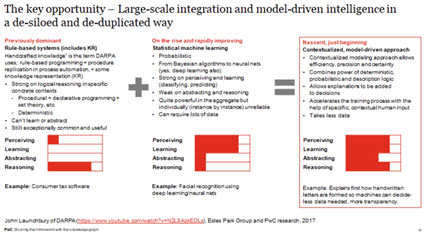It is a dangerous time for CPAs right now. The term "AI" is now a buzz word. Everyone and their brother is now trying to sell you AI. Don't be duped by the snake oil salesmen. Get educated.
As I explain in the document Computer Empathy (which would be a really good thing for CPAs to read); there are two major techniques for implementing artificial intelligence:
- Logic and rules-based approach (expert systems): Representing processes or systems using logical rules. Uses deductive reasoning.
- Machine learning (pattern-based approach): Algorithms find patterns in data and infer rules on their own. Uses inductive reasoning; probability.
You can combined both approaches and create a third approach which is a hybrid of both approaches: (larger image)
Implementing a "good old fashion expert system" is a lot of work. A logic and rules-based approach is based on what amounts to an ontology which can be hard to get right but once you have this high-quality curated information; it can literally supercharge AI and make it do wonderful and useful things. This is proven technology, it works, but it is expensive and time consuming to get right.
Many computer scientists would have you believe that machine learning or "deep learning" (they are the same thing) will help you get around all the hard work and expense of a logic and rules-based approach to implementing AI. But current machine learning type systems are being characterize as doing basically "cheap parlor tricks" and they are a fragile house of cards rather than a solid foundation.
Machine learning or deep learning systems work best if the system you are using them to model has a high tolerance to error. These types of systems work best for:
- capturing associations or discovering regularities within a set of patterns;
- where the volume, number of variables or diversity of the data is very great;
- relationships between variables are vaguely understood; or,
- relationships are difficult to describe adequately with conventional approaches.
Machine learning basically uses probability and statistics, correlations. This is not to say that machine learning is a bad thing. It is not, it is a tool. Any craftsman knows that you need to use the right tool for the job. Using the wrong tool will leave you unsatisfied.
There are no short cuts. No one disputes the need for a "thick layer of metadata" to get a computer to perform work. What is disputed is the best way to get that thick layer of metadata. Machine learning works best if you already have a thick layer of metadata, that is the training data that machine learning needs to work.
What is needed first is a theory and framework. You use that theory and framework to build a machine readable ontology. Here are my theories for financial reports and business reports. And here is my ontology prototype for US GAAP. Folks, this is hard work.
Are you aware of the AICPA's Dynamic Audit Solution Initiative? Is that initiative going down the right path? How do you know? Can those creating this new approach to auditing prove that it will work? Can they provide you with testing results that help you understand and evaluate if it will work? What are the requiements of this new approach? Do CPAs even have enough background understanding of artificial intelligence to ask good questions?
Again, there are no short cuts.
